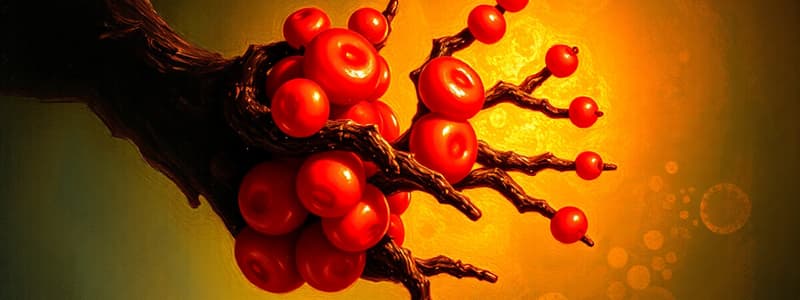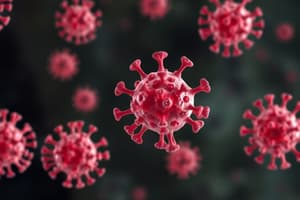Podcast
Questions and Answers
What characterizes active adaptive immunity compared to passive adaptive immunity?
What characterizes active adaptive immunity compared to passive adaptive immunity?
- Active adaptive immunity relies on preformed antibodies for protection.
- Active adaptive immunity is temporary and short-lived.
- Active adaptive immunity provides immediate protection.
- Active adaptive immunity involves the production of antibodies by the host. (correct)
Which of the following is NOT a feature of passive adaptive immunity?
Which of the following is NOT a feature of passive adaptive immunity?
- Transplacental transfer of antibodies.
- Uses preformed antibodies for quick response.
- Lasts longer than natural immunity. (correct)
- Confers immediate protection.
What is the primary role of macrophages in the adaptive immune response?
What is the primary role of macrophages in the adaptive immune response?
- To directly kill foreign pathogens.
- To secrete cytokines that enhance innate immunity.
- To produce antibodies for infection control.
- To process and present antigens to lymphocytes. (correct)
How does active artificial immunity typically achieve its objective?
How does active artificial immunity typically achieve its objective?
What leads to the downregulation of the adaptive immune response?
What leads to the downregulation of the adaptive immune response?
Which statement accurately describes the function of CD4 T cells?
Which statement accurately describes the function of CD4 T cells?
What distinguishes the primary roles of B-lymphocytes from T-lymphocytes?
What distinguishes the primary roles of B-lymphocytes from T-lymphocytes?
What triggers the differentiation of CD8 positive T-cells into cytotoxic T lymphocytes?
What triggers the differentiation of CD8 positive T-cells into cytotoxic T lymphocytes?
Which component of the adaptive immune response is involved in the elimination of intracellular pathogens?
Which component of the adaptive immune response is involved in the elimination of intracellular pathogens?
During the adaptive immune response, which process occurs immediately after antigen processing and presentation?
During the adaptive immune response, which process occurs immediately after antigen processing and presentation?
What is the primary role of antigen presenting cells (APCs) in the immune response?
What is the primary role of antigen presenting cells (APCs) in the immune response?
Which component is NOT involved in the activation of T-helper cells?
Which component is NOT involved in the activation of T-helper cells?
Which cytokines are primarily associated with Th1 cell activation?
Which cytokines are primarily associated with Th1 cell activation?
What is the significance of Th2 cells in the immune response?
What is the significance of Th2 cells in the immune response?
Which of the following statements correctly describes the role of Th17 cells?
Which of the following statements correctly describes the role of Th17 cells?
What initiation step is required for T-cell dependent B-cell activation?
What initiation step is required for T-cell dependent B-cell activation?
Which of the following cytokines is produced by Th2 cells?
Which of the following cytokines is produced by Th2 cells?
What is the role of cytokines released from T-helper cells in relation to B lymphocytes?
What is the role of cytokines released from T-helper cells in relation to B lymphocytes?
Which of the following scenarios would most likely stimulate Th1 cell responses?
Which of the following scenarios would most likely stimulate Th1 cell responses?
Which type of immune response is mainly triggered by Th1 cytokines?
Which type of immune response is mainly triggered by Th1 cytokines?
Flashcards
Active Adaptive Immunity
Active Adaptive Immunity
This type of immunity is acquired through exposure to a foreign antigen, causing the host to develop its own antibodies and immune cells.
Passive Adaptive Immunity
Passive Adaptive Immunity
This immunity involves receiving antibodies from an external source, such as a mother to her child through breastmilk, without the body actively producing them.
What is the primary immune Response?
What is the primary immune Response?
The immune system's initial response to a specific antigen exposure. This response is slower and less robust than the subsequent responses.
What is the secondary immune response?
What is the secondary immune response?
Signup and view all the flashcards
What is Immunological Memory?
What is Immunological Memory?
Signup and view all the flashcards
What are T lymphocytes?
What are T lymphocytes?
Signup and view all the flashcards
What are regulatory T cells (T regs)?
What are regulatory T cells (T regs)?
Signup and view all the flashcards
What are Cytotoxic T Lymphocytes (CTLs)?
What are Cytotoxic T Lymphocytes (CTLs)?
Signup and view all the flashcards
What is Humoral immunity?
What is Humoral immunity?
Signup and view all the flashcards
What is Cell-mediated immunity?
What is Cell-mediated immunity?
Signup and view all the flashcards
Antigen processing and presentation
Antigen processing and presentation
Signup and view all the flashcards
Antigen presenting cells (APCs)
Antigen presenting cells (APCs)
Signup and view all the flashcards
T cell receptor (TCR)
T cell receptor (TCR)
Signup and view all the flashcards
Major histocompatibility complex (MHC)
Major histocompatibility complex (MHC)
Signup and view all the flashcards
Costimulation
Costimulation
Signup and view all the flashcards
T-helper cell (Th cell)
T-helper cell (Th cell)
Signup and view all the flashcards
Th1 cells
Th1 cells
Signup and view all the flashcards
Th2 cells
Th2 cells
Signup and view all the flashcards
Th17 cells
Th17 cells
Signup and view all the flashcards
T-cell dependent activation of B cells
T-cell dependent activation of B cells
Signup and view all the flashcards
Study Notes
Adaptive Immune Response
- Adaptive immunity is highly specific, has immunological memory, and reacts quickly to repeated exposure to antigens.
Forms of Adaptive Immunity
- Active Adaptive Immunity: The host actively produces antibodies in response to foreign material, lasting longer than passively acquired antibodies.
- Active Natural Immunity: Immunity developed after exposure to a pathogen (e.g., infection).
- Active Artificial Immunity: Immunity resulting from vaccination with killed or weakened pathogens.
- Passive Adaptive Immunity: Provides temporary immunity through pre-formed antibodies.
- Passive Natural Immunity: Antibodies passed from mother to fetus (e.g., IgG across placenta) or through breast milk (e.g., IgA).
- Passive Artificial Immunity: Pre-formed antibodies (e.g., antitoxins) are administered to provide immediate protection, often used for exotoxins.
Cells Involved in Specific Immune Response
- Macrophages: Phagocytic cells that process and present antigens to lymphocytes, acting as antigen-presenting cells.
- T lymphocytes (T cells): Originate in bone marrow, mature in the thymus. Have various subsets with specific functions.
- CD4 effector cells (Th1, Th2, Th17): Involved in coordinating immune responses. T regulatory cells (T regs) suppress immune responses.
- CD8 positive T cells (cytotoxic T lymphocytes – CTLs): Destroy infected or cancerous cells.
- B lymphocytes (B cells): Mature in bone marrow, responsible for humoral immunity. Carry IgM as receptors. Differentiate into plasma cells to secrete antibodies.
Adaptive Immune Response Steps
- Antigen processing and presentation: Antigens are processed and displayed on antigen-presenting cells (APCs) for recognition by T helper cells.
- Activation of T helper cells: Requires three signals (TCR interaction, co-stimulation, cytokines) from APCs.
- Activation of cytotoxic T cells: CTLs are activated by antigen presented on MHC class I molecules and cytokines. Kill infected cells.
- Activation of B cells: Two pathways, either T cell-dependent (requires T helper cells) or T cell-independent (no T cell help).
- Elimination of the offending antigen: Successful immune response leads to pathogen elimination and downregulation of the immune response by regulatory T cells.
Antibody Responses
- Primary Response: Initial antibody production after first encounter with antigen. Characterized by IgM production followed by IgG.
- Secondary Response: Subsequent exposure to the same antigen results in a faster and stronger response (higher antibody levels) due to memory cells. Characterized by a rapid increase in IgG production.
Innate and Adaptive Interaction
- Innate and adaptive immunity work together. Phagocytic cells present antigens & macrophages secrete cytokines activating the adaptive immune system. T cells influence phagocytic cells' activities; antibodies enhance pathogen clearance.
Studying That Suits You
Use AI to generate personalized quizzes and flashcards to suit your learning preferences.




